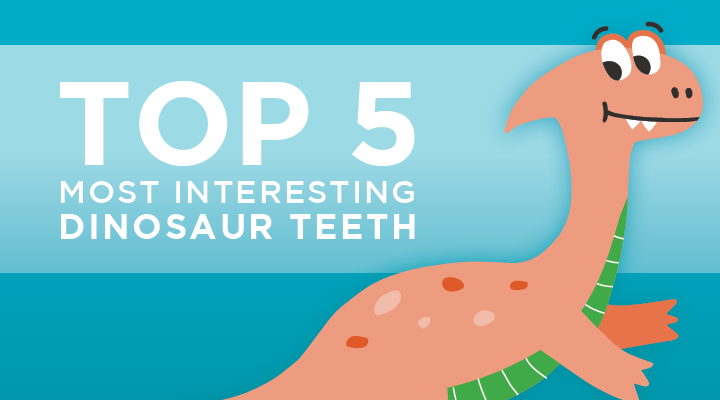Millions of years ago, dinosaurs ruled the earth. It’s estimated that there were up to 700 different species in the ancient world. This left room for a lot of different types of teeth. Just like animals today, dinosaurs had teeth that were perfect for their specific needs, whether it was tearing open prey or grinding leaves.
In honor of Dinosaur Day in June, we would like to highlight some of the most interesting dinosaur teeth.
Types of dinosaur teeth
Dinosaur teeth came in all different shapes and sizes. Let’s find out more about the teeth of some of the most popular dinosaurs:
Tyrannosaurus rex teeth
Also known as the T.rex, this dinosaur is known for being a top predator roaming the earth during the Late Cretaceous Period. One of the reasons for this is because of their large bodies and sharp teeth. These carnivores had 60 serrated teeth that were roughly eight inches long, so you can only imagine what they did to their prey.
Triceratops teeth
The Triceratops is one of the most visually iconic dinosaurs ever discovered thanks to the three giant horns sticking out of its head. However, we think its teeth were even more fascinating. Triceratops had roughly 800 teeth, with new ones constantly growing throughout their life. Having that many teeth is hard to imagine, but Triceratops’ teeth grew in “batteries of 36 to 40 tooth columns with each column having three to five teeth vertically stacked on one another.” When their teeth would get worn down, these herbivores would simply produce more to replace them.
Pterodactyl teeth
Not much is known about these flying reptiles, which makes facts about their teeth hard to come by. A full-grown Pterodactyl likely had 90 teeth while younger ones had around 15. Most fossils that have been found show they typically had a mix of conical and narrow teeth. While scientists aren’t exactly sure what they ate, many believe they were carnivores that fed on small animals or possibly invertebrates.
Stegosaurus teeth
One of the most fascinating dinosaurs, Stegosaurus is known for the dual rows of plates protruding from its back. The Stegosaurus is also believed to have been able to fend off predators, like an Allosaurus, with its strong, spiked tail. Their dinosaur teeth were “a series of rounded, minutely-ridged teeth arranged in straight rows from front to back,” and were only a centimeter big. Despite being roughly the size of a bus and weighing almost 14,000 pounds, the creature had to feed on smaller and softer plants due to its weak jaws.
Brachiosaurus teeth
The Brachiosaurus were giant and had extremely long necks, similar to a giraffe. Paleontologists believe the Brachiosaurus had thick jaw bones and spoon-shaped teeth, which allowed them to feed on vegetation like coniferous trees. These monstrous dinosaurs only ate plants, and it’s believed they used their teeth to swallow vegetation whole.
Megalodon teeth
Although often considered a dinosaur, the Megalodon didn’t coexist with those other ancient creatures. It was alive nearly 40 million years later. The Megalodon was a massive fish that weighed as much as 30 large great white sharks. These giants grew to be 40 to 60 feet long, and their teeth reflect how large these apex predators were. Megalodon teeth were sharp, about the size of a banana, and have been discovered all around the world.
Celebrating dinosaur teeth for Dinosaur Day
Each dinosaur that existed had some variation of dinosaur teeth that were specifically suited for their dietary needs. This is just one reason why we think dinosaur teeth are so fascinating! In today’s world, many modern animals use teeth that have similarly evolved for their needs. Teeth are truly amazing!
Looking for more fun animal teeth facts? Check out this blog: Meet the Quokka: The Smiliest Animal in Honor of National Smile Month.

